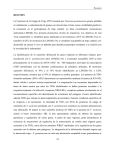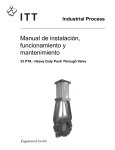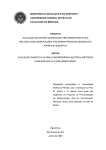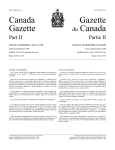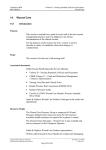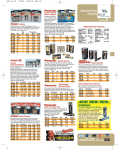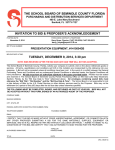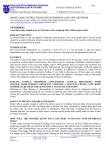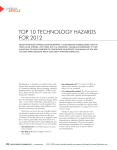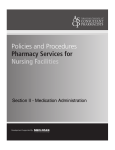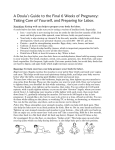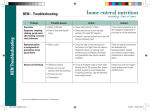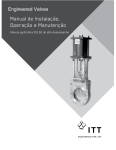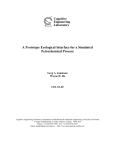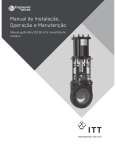Download Percutaneous Enteral Feeding Tube Care
Transcript
Section: ADL Subsection: Eating/Nutrition/Diet PERCUTANEOUS ENTERAL FEEDING TUBE CARE CS-02-01-03 Page 1 of 16 Related terms: Tube Feeding, Changing Gastrostomy, Jejunostomy Care Date Established: March 1999 Dates Revised: Authorized by: Clinical Directors March 2006 March 2009 May 2012 Date For Review: May 2015 RATIONALE To provide direction for the safe administration of enteral feeding solution through a percutaneous enteral tube. APPLICABILITY: MD, RD (Registered Dietitian), RN/LPN. Resident Assistants (RAs) at Nickel House and Signal Pointe and Therapy Aides (TAide) at YADS can administer feedings after completion of a G-tube course provided by Education Services. DEFINITION Reinsertion: Inserting a balloon tip gastrostomy tube (that has accidentally been removed or has fallen out, or when an in situ tube requires replacing) into the stomach. Mature tract: A tract between the abdominal wall and the stomach is considered mature after 6 weeks. Percutaneous Enteral Tube A tube that is inserted through an artificial opening in the stomach or small intestine, usually for the purpose of long term feeding. Such as: ● Gastrostomy Tube (G-tube) The tip of the tube rests in the stomach and exits the body through a tract created in the abdominal wall. ● Gastro-duodenal Tube (GD tube) Stomach gastro-duodenal tube inserted through the abdominal wall into stomach and advanced into duodenum. Jejunostomy Tube (J-tube or GJ tube) Tip of the tube rests in the jejunum. The tube exits the body through a tract created in the abdominal wall. CAREWEST Care and Service Manual Section: ADL Subsection: Eating/Nutrition/Diet PERCUTANEOUS ENTERAL FEEDING TUBE CARE Percutaneous Endoscopic Gastrostomy Tube (PEG ) CS-02-01-03 Page 2 of 16 Percutaneous stab into the stomach with endoscopic assistance for a tube placement. The tube is anchored by a retention suture, not a balloon. Removal and reinsertion is a medical procedure. Initial change to a PEG-Tube is performed by a physician. ● Balloon anchored tube A tube that has an expandable balloon on the end which is inflated with sterile water for the purposes of securing the tube in the correct location once in situ. Flange The disk that anchors some tubes on the exterior side of the abdominal wall. Open Enteral System An enteral system in which the formula is added into the enteral container or bag. Closed Enteral System A closed enteral container or bag, pre-filled with sterile, liquid formula by the manufacturer, and considered ready to administer. Continuous feed Solution is instilled slowly into the feeding tube – often over 12-16 hours using a pump. Flush the tube every 4 hours. J-tubes must have continuous feed as the jejunum has no reservoir for holding a large volume of feeding solution. Intermittent feed Feeding solution is run a number of times a day over 30-45 minutes/can (approximately 276 mL) of feeding solution into the gastric cavity. POLICY 1. Gastrostomy or Jejunostomy tubes may be considered for longer term use to ensure that optimum nutrition and comfort needs are met. The client or guardian will be consulted and must consent to the insertion of the feeding tube. 2. A physician's order is needed to initiate and end enteral feeding. The dietitian (RD) must be consulted for all clients with gastrostomy/ jejunostomy tube feeds to ensure that the client is receiving optimum nutrition and hydration. The type of CAREWEST Care and Service Manual Section: ADL Subsection: Eating/Nutrition/Diet PERCUTANEOUS ENTERAL FEEDING TUBE CARE CS-02-01-03 Page 3 of 16 formula, need for modular additives, rate, frequency and volume of water flush is determined by a RD or physician. Note: Tube feedings usually do not start any sooner than 24 hours after the insertion of a radiological or endoscopically placed gastrostomy tube. 3. The feeding solution should be given at room temperature, but not left open at room temperature for more than 12 hours. Open System: Literature suggests that a hang time of 8 to 12 hours is acceptable for commercially sterile ready-to-feed products when carefully poured from the packaged container into a tube-feeding set-up. Mark the date and time opened and store open cans in the refrigerator. Discard refrigerated product if not used within 48 hours. Closed System: Ready-to-hang products may hang for 24 to 48 hours (depending on manufacturer’s guidelines), when a new ready-to-hang container is spiked with a new feeding set using aseptic technique. Otherwise, hang no longer than 24 hours. Mark the date and time spiked on the container. 4. The client should be in an upright position (minimum 30° and preferably to 45°) during feeding, medication administration, and/or flushes, and for 30-60 minutes afterward, if tolerated, to avoid reflux into the esophagus and possible aspiration. 5. Strict adherence to clean technique is required in the preparation and administration of enteral formulas. All devices/tubing for an open system are to be changed at least every 24 hours as per manufacturer’s directions. Closed system feeding sets must be changed as per manufacturer’s guidelines every 24 to 48 hours. 6. Medications, modular additives such as protein powder or juice are not added directly into the formula. Consult Dietitian for further direction. 7. Placement of Tube: Check the tube placement immediately after reinsertion and: ● before each intermittent feeding. ● before medication administration. ● if the tube is accidentally pulled. ● if the mark on the tube is in a different position than indicated on the Health Record. CAREWEST Care and Service Manual Section: ADL Subsection: Eating/Nutrition/Diet PERCUTANEOUS ENTERAL FEEDING TUBE CARE 8. CS-02-01-03 Page 4 of 16 ● if the client feels the placement is in question. ● after excessive vomiting, retching or coughing. ● after abdominal spasm. (Use “smooth tip” to anchor the tube for clients with severe abdominal spasms – to prevent the tube being sucked into the stomach.) (Clients with MS may benefit from an anti-spasmodic medication.) ● if there is a change in the client's condition such as vomiting and retching, abdominal pain, cramping, bloating, fullness or burning with feedings. ● if there is an unusual leakage around the tube. ● if the balloon type tube is fixated in the tract, i.e. will not rotate. Flushing the Tube: Percutaneous enteral feeding tubes must be flushed: ● before and after each intermittent feed. ● before and after medication administration. ● at least every 4 hours with continuous feeds or when feeding is interrupted. ● if a blockage is suspected. To maintain patency of the tube it must be flushed regularly. If the gastrostomy/PEG tube is not used for nutritional purposes and the client is not on NPO, the gastrostomy/PEG tube should be flushed twice a day. If the jejunostomy tube is not used for nutritional purposes and the client is not NPO, it should be flushed every 4 hours. PROCEDURE 1. Care of the Newly Inserted Feeding Tube: The following are suggested topics to consider when setting up the interdisciplinary care plan for a client with a newly inserted feeding tube: ● Determine the type of tube that was inserted to help establish care of the current tube. Check the physician’s orders. ● Determine when and how any retention sutures are to be removed. Retention sutures are used to help form the track by holding the stomach CAREWEST Care and Service Manual Section: ADL Subsection: Eating/Nutrition/Diet PERCUTANEOUS ENTERAL FEEDING TUBE CARE CS-02-01-03 Page 5 of 16 against the abdominal wall. Often they are removed 10-14 days post surgery by the surgeon in a booked clinic appointment. ● Consult the dietitian to determine formula, frequency, rate of flow, gravity or pump, and amount of flushes. ● Discuss any need to check residual gastric contents to monitor tolerance to feeds. ● Discuss how best to monitor client condition: lab work, weight, bowel function, urine output; blood glucose monitoring, etc. ● An enteral feeding pump may be required if the client is returned to care center before progressing to an intermittent feeding schedule or a gravity feed. If required, contact Education Services for just in time education. ● Determine stoma site care, including when showering or bathing (swimming), can resume. ● The plan for reinsertion of the tube if tube becomes blocked or is accidentally removed: 1. immature tract; 2. initial tube change in mature tract; and 3. mature tract regular change intervals. Determine: 2. ● the replacement tube type and size. ● where the reinsertion is to take place (in the care center or by a booked appointment at a physician’s office or clinic). ● who will re-insert the first tube (the first replacement is done by a physician unless the tract is very well established -greater than 3 months (see policy CS-02-01-04). ● Discuss with pharmacy how medications will be administered through the tube. Procedure to Check for the Correct Placement of the Tube: 2.1 Check that the external length of the tube extending beyond the exit site has not changed upon subsequent care, before each flushing, tube feeding, and/or medication administration by using the ruler marking on the tube or mark placed there with an indelible pen. Check the exit length on the Total Team Record and Care Plan. CAREWEST Care and Service Manual Section: ADL Subsection: Eating/Nutrition/Diet PERCUTANEOUS ENTERAL FEEDING TUBE CARE CS-02-01-03 Page 6 of 16 2.2 Assess the client’s tolerance to feeds or flushes each time (e.g. shortness of breath, cough, abdominal pain, nausea and vomiting, leakage at site). 2.3 If the placement is in question: ● G-tube- Use a 60 mL piston syringe to aspirate the contents of the stomach. Reposition the client if unable to aspirate the contents. Aspiration is not always possible if the stomach is empty. ● J-tube- Attempt to aspirate bearing in mind that the jejunum is not a reservoir so fluid is not easily obtained. ● Observe the contents of the aspirate, if obtained. Check the pH of the aspirate using litmus paper. Compare the aspirate to the chart below. Note: pH testing is more reliable if performed prior to or 60 minutes after the administration of medications and tube feedings. Fluid pH Factors affecting pH Color of Fluid Stomach 1-5 pH may be due to Histamine H2-receptor blocking agents (cimetidine, famotidine, nizatidine, and ranitidine), omeprazole and antacids. Grassy or cloudy green, tan to offwhite, bloody or brown. pH may be due to chronic gastritis, refluxing of duodenal and pancreatic secretions into stomach. On rare occasions, clear and colorless. Mucus may be mixed in with gastric fluid. NOTE: Gastric pH of higher than 3.5promotes bacterial colonization and increases risk of aspiration pneumonia. Intestine Greater than 5 but less than 7 Medium to deep golden yellow. CAREWEST Care and Service Manual Section: ADL Subsection: Eating/Nutrition/Diet PERCUTANEOUS ENTERAL FEEDING TUBE CARE ● 2.4 CS-02-01-03 Page 7 of 16 If pH of the aspirate indicates correct placement, re-instill the aspirated fluid. Note: Discard the aspirate if it is bloody, mucousy, or bile stained. "Hold" any flush/ feeding solution/medication if there is any doubt about the location of the tube. Contact the physician. Note: An x-ray may be required to confirm the tube placement. 3. Procedure for Flushing Feeding Tubes: 3.1 Unless otherwise directed by the registered dietitian or physician, flush using the following guidelines: Use a minimum of 30 mL room temperature water (sterile water for immunocompromised clients) in a 60 mL piston syringe. Note. To prevent exerting too much pressure on the tube, it is important to use a large syringe (e.g. 60 mL) unless otherwise allowed by manufacturer's recommendations. If fluids are restricted, flush with less fluid. Point of emphasis: Regular flushing with water is the single most effective way of ensuring patency of the feeding tubes. Flushing with other liquids, such as carbonated beverages or cranberry juice, is not considered best practice. 4.0 3.2 When flushing, use a “push and pause” motion several times for first half of flush before a steady push with the last half of the flush. 3.3 Discard remaining water. Change flushing equipment weekly. Care of stoma and tube 4.1 Syringes, feeding bag, and line require secure attachment to the feeding tube. Use appropriate adaptors on the end of the feeding tube, if necessary, to ensure a secure fit (e.g. use a Luer-lock 60 mL syringe into feeding tube with a Leur-lock, or use an adapter to allow a slip-tip 60 mL syringe and feeding bag line to attach appropriately). Do not use a bulb syringe as this equipment does not allow for “push and pause” flushing technique. 4.2 Post-operatively, the dressing may be removed from the tube site after 24 to 48 hours. However, it is important that the tube is secured to prevent movement. CAREWEST Care and Service Manual Section: ADL Subsection: Eating/Nutrition/Diet PERCUTANEOUS ENTERAL FEEDING TUBE CARE CS-02-01-03 Page 8 of 16 4.3 Bathing, showering and swimming are allowed with an established stoma site. Post-operatively the surgeon/physician determines when the client may start bathing, showering and swimming. 4.4 Follow standard precautions when providing care to the stoma and tube. Qtips and/or gloves may be used to protect staff from gastric secretions. 4.5 Remove any dressings, and note the amount and character of any drainage. Examine the skin integrity. If the skin around the gastrostomy/jejunostomy tube is red or open, consider consulting a Skin and Wound Resource regarding appropriate use of skin barriers. 4.6 A fresh stoma should be cleansed with normal saline for the first 14 days after insertion, or if showing signs of infection. A well healed stoma can be cleansed with soap and water or an approved skin cleanser. Wipe in widening circles starting from the tube exit site. Apply a mild, but adequate, pressure in cleaning around the entire tube and skin circumference to ensure a clean margin and prevent the adherence of the tube to the skin. Remove any build up of oils or formula around the tube opening or connectors. 4.7 Check the tube tension daily, making sure that it is secure and that it is not causing undue pressure. Expect some in-and-out play of about 0.5 cm but no side-to-side motion. 4.8 For a radiologically inserted PEG do not do 360˚ tube rotation which may uncoil and dislodge the tube. Do not rotate a jejunostomy tube. Tube rotation is also not advised when there is purse string suture around the stoma and for at least 3 weeks after suture removal, or for the duration as directed by the physician. For other types of gastrostomy tubes, gently rotate the tube daily. 4.9 For tubes with an external retention device - gently lift the edges of the retention disc, or bumper away from the skin while cleaning. While drying the skin and disc, gently turn the disc. For Button (low-profile gastrostomy device or skin level device) - turn the button while drying the skin to make sure the skin under the tabs is dry. 4.10 Apply a dressing, if exudate is present. Usually a dressing is no longer required several days post initial tube insertion. If dressing changes are required, perform daily or more frequently, as required. CAREWEST Care and Service Manual Section: ADL Subsection: Eating/Nutrition/Diet PERCUTANEOUS ENTERAL FEEDING TUBE CARE CS-02-01-03 Page 9 of 16 4.11 Anchor the gastrostomy / jejunostomy tube securely with a tube holder, flexi-track, duoderm or breathable tape. If needed, use hypoallergenic tape. To prevent unnecessary tugging on the device, the tube may be coiled and secured to the client’s clothing. Although use of a Foley catheter as a feeding tube is NOT recommended, if one is in place it is critical that a cross piece or tape flag be added to the Foley catheter exiting the stoma to prevent the migration of the catheter balloon beyond the pylorus of the stomach. 4.12 Deflate the feeding tube balloon (if present) monthly to check colour and amount of water in the balloon. If the water is brown tinged or the amount withdrawn is less than was originally placed in balloon (usually half the amount recommended on the tube) consider changing the tube as these may be signs that the balloon is degrading. 4.13 Dispose of the equipment and wash your hands. CAREWEST Care and Service Manual Section: ADL Subsection: Eating/Nutrition/Diet PERCUTANEOUS ENTERAL FEEDING TUBE CARE CS-02-01-03 Page 10 of 16 Troubleshooting common gastrostomy / jejunostomy tube and skin care problems: Problem Possible Causes Action/Intervention Leakage around tube or stoma 1. Improper client positioning. 1. Place client in upright position at 30º during feedings and for at least one hour following intermittent feedings. 2. Decreased gastrointestinal function. 2. Hold feedings and alert physician. Assess for decreased or absent bowel sounds, abdominal distension, nausea, vomiting and increased residual volume. 3. Balloon/mushroom or catheter has slipped away from wall of stomach. 3. Gently pull back on catheter or tube to ensure that balloon is snug against stomach wall and secure in place. 4. Balloon of the catheter may have become less inflated. 4. Check contents of the balloon – if amount is less than was originally used to inflate balloon, or if balloon contents are brown-tinged in colour, consider changing tube as this may indicate the balloon is degrading. 5. Tube is too small for size of stoma. 5. Stabilize tube to abdomen to prevent tension on the tract. Reinflate balloon to manufacturer's recommended capacity. Consult with physician to evaluate further. 6. Tube migration inward causing partial pyloric obstruction. 6. Check external tube length. If tube is shorter than when inserted, stop feeding. Assess for nausea, vomiting and abdominal distension. If symptoms are present, alert physician. X-ray may be needed to determine tube placement. 7. Tube migration outward, allowing feeding to enter tract. 7. Check external tube length. If tube is longer, stop feeding and consult physician whether tube needs replacement. 8. Anti-reflux valve failure. 8. Notify the physician for consultation re: necessity for tube replacement. 9. Feeding rate too rapid or volume too large. 9. Consult physician and dietitian about necessity to decrease the rate or volume of feedings, or switch to continuous feedings. CAREWEST Care and Service Manual Section: ADL Subsection: Eating/Nutrition/Diet PERCUTANEOUS ENTERAL FEEDING TUBE CARE CS-02-01-03 Page 11 of 16 Problem Possible Causes Action/Intervention Skin irritation or redness around tube or stoma 1. Gastric fluid leakage around tube. 1. Clean area around tube or stoma frequently; keep dressing dry; change catheter tube holder if soiled; check tube placement and keep 1 –2 mm distance between the retention bumper and the skin. 2. Reaction to tube material. 2. Suggest tube be replaced. 3. Tube migration outward. Bumper not in place to prevent tube from moving. Bleeding around 1. Bleeding may occur during tube change. tube or stoma 2. The stoma may become irritated from movement of the tube in the stoma. Tissue build up around tube 1. 3. Check external tube length. If it becomes longer, stop feeding and consult physician whether tube needs replacement. 1. Minimal bleeding is insignificant. The physician should be consulted if larger amounts of bleeding occur. 2. Secure the tube to the client's abdomen using a catheter tube holder. Ensure bumper is in place to prevent movement of the tube. A small amount of 1. Keep site dry, secure the tube well to decrease movement. epithelial tissue is 2. If tissue build-up is excessive and interferes with care, notify the normal and not painful. physician. 3. Removal of the hypergranulation may be necessary by physician (often with silver-nitrate – two-three times/wk for 2-3 weeks). Tube deterioration Gastrostomy tube falls out. 1. Normal usage. 2. Irrigations not performed regularly. 3. Faulty Anchoring device. 1. Insufficient water or saline in balloon or balloon rupture. Notify physician. Tube will need to be replaced. 1. Insert re-placement gastrostomy tube as soon as possible. 2. If the correct size of gastrostomy tube is not available, a Foley catheter or another similar size gastrostomy tube can be inserted until a proper replacement tube can be obtained. 3. Smaller size tube can be used for constricted tract. CAREWEST Care and Service Manual Section: ADL Subsection: Eating/Nutrition/Diet PERCUTANEOUS ENTERAL FEEDING TUBE CARE CS-02-01-03 Page 12 of 16 Problem Possible Causes Action/Intervention Balloon rupture 1. Over inflation of balloon. 1. Insert new tube, as ordered. Inflate new balloon to half manufacturer's recommendations. 2. Increased intraabdominal pressure from coughing, crying, spasticity, or seizure disorders. 2. For clients, alert physician and obtain order for antispasmodic to help relax abdominal muscles. 3. Deterioration of the G- 3. tube balloon from yeast formation or exposure to gastric and pancreatic juices. Balloon won't deflate 1. Occlusion in the balloon channel from yeast formation or inadvertent administration of medication into the balloon port. 2. Defective valve. Monitor for deterioration by checking water volume in balloon weekly. The best time to do it is before a feeding when the stomach is empty. 1. Never forcibly remove a tube when the balloon will not deflate. 2. Attempt to deflate the balloon by injecting 1-2 mL of sterile water or saline into the balloon valve using a Luer-tip syringe and then try to deflate. Alternately, push balloon further into the stomach (so it is not lying right against the abdominal wall) and hyper-inflate the balloon with air or sterile water to rupture it. 3. If that doesn't work, remove the piston from the syringe barrel. Insert the syringe into the balloon valve and place it on a clean towel at a level below the balloon. Allow it to drain for 5 - 10 minutes. If there is no drainage, the problem may be a defective valve rather than an occlusion in the balloon channel. 1. If the valve is defective, contact the physician to discuss the option of cutting off the Y-port. If this option is agreed upon, cut off the entire Y-port with scissors and allow the fluid to drain through the balloon channel. Stay with client until the G-tube is removed to prevent migration of the tube inward. 2. If removing the Y-port doesn't work, contact the physician. CAREWEST Care and Service Manual Section: ADL Subsection: Eating/Nutrition/Diet PERCUTANEOUS ENTERAL FEEDING TUBE CARE CS-02-01-03 Page 13 of 16 Problem Possible Causes Action/Intervention Diarrhea 1. Contaminated formula/equipment 1. 2. Rapid infusion rate 2. Initiate and advance formula rate gradually; reduce rate 3. Post anti-biotic use (check for C-diff (clostridium difficile). 3. Change antibiotic to treat C-diff if indicated. Consider a probiotic. 4. Medication side effect 5. Cold formula 5. Ensure feeding solution is given at room temperature (extremes in temperature may stimulate peristalsis). 6. Malabsorption (short bowel syndrome, radiation enteritis, compromised pancreatic function, severe Crohn’s disease) 6. Change formula (in consultation with dietitian/physician) . 7. Possible gastroenteritis. 7. Consult Physician. 1. Too fast a rate 1. Stop feed. Provide feeds at a slower rate. 2. Client laying too flat 2. Keep patient in 30°, preferably 45° during feed and for about 1 hour after feeds. 3. Underlying medical condition 3. Contact physician if symptoms continue. 4. Change feeding bag and feeding line and pay close attention to proper hand washing before and after providing care to feeding tube or feeding solution. Review medication use (hyperosmolar meds may cause diarrhea). Dumping syndrome (sensation of fullness, faintness, palpitation, diarrhea)-occurs more frequently when tube placed in jejunum. Reflux / Regurgitation CAREWEST Care and Service Manual Section: ADL Subsection: Eating/Nutrition/Diet PERCUTANEOUS ENTERAL FEEDING TUBE CARE CS-02-01-03 Page 14 of 16 Problem Possible Causes Action/Interventions Constipation 1. Inadequate water intake 1. Increase free water intake. 2. Inadequate fibre intake 2. Consult Dietitian to assess fibre intake. 3. Low Activity 3. Increase activity as able. 4. Reduced gastric motility 4. Reassess bowel routine. 5. Medications side effect 5. Consult Physician/Pharmacist. 1. Feeding solution too great a volume and at too rapid of an infusion rate 1. Consider a slow rate of infusion 2. Gastric Retention 2. Check residual gastric contents prior to next feed. Hold feed for two hours if more than ½ previous infused amount is residual or more than 50% of the hourly rate for continuous infusions. 3. Cold Formula 4. Dumping syndrome (sensation of fullness, faintness, palpitation, diarrhea – occurs more frequently when tube placed in jejunum) Abdominal distention nausea and vomiting 5. Client laying to flat Consider smaller, more frequent feeding schedule (q.i.d. instead of t.i.d.) 3. Bring formula to room temperature before use. 4. Contact physician Consult dietitian to assess delivery schedule and to assess appropriateness of current formula. 5. Ensure resident is upright for feeds. Raise head of bed greater than 30°, check gastric residuals. CAREWEST Care and Service Manual Section: ADL Subsection: Eating/Nutrition/Diet PERCUTANEOUS ENTERAL FEEDING TUBE CARE CS-02-01-03 Page 15 of 16 CROSS REFERENCES Medication Administration CS-06-06-01 Percutaneous Enteral Feeding Tube Reinsertion CS-02-01-04 Declogging Percutaneous Enteral Feeding Tube CS-02-01-05 Skin Care Protocol CS-02-04-06 REFERENCES Bankhead R, Boullata J, Brantley S, Corkins M, Guenter P, Krenitsky J, Lyman B, Metheny NA, Mueller C, Robbins S, Wessel J, ASPEN Board of Directors (2009). A.S.P.E.N. Enteral Nutrition Practice Recommendations. JPEN, 33; 122. online version available at http://pen.sagepub.com Bockus, Sherry. (1998) When Your Patient Needs Tube Feedings, Nursing CE Handbook, http://www.springnet.com/ce/p507a.htm, SpringNet - CE Connection, obtained on 2001-08-30. Bowers, Sybil. (2000) All About Tubes: Your Guide To Enteral Feeding Devices. Nursing 2000, 30(12), 41-47. Broscious, S. (1995) Preventing Complications of PEG Tubes. Dimensions of Critical Care Nursing, 14(1), 37-41. Care in the Community, Service Performance Committee, Gastric-tube Ad Hoc Working Group. (April, 2002) Towards the Development of an Operational Guideline to Support Enteral Nutrition in Calgary Health Region Continuing Care Facility Settings – Ad hoc Committee Report. Calgary Health Region. Calgary Health Region. (2005). Enteral Tubes: Percutaneous Tube Maintenance, Troubleshooting and Reinsertion of Balloon Type G-Tubes. Regional Nursing Policy and Procedure Manual. ( # T-16). Calgary Health Region. (2005). Enteral Tubes: Assessment of Placement. Regional Nursing Policy and Procedure Manual. ( # T-17). Grant, Mary and Martin, Sarah. (2000). Delivery of Enteral Nutrition, AACN (American Association of Critical-Care Nurses) Clinical Issues, 11(4), November 507-516. CAREWEST Care and Service Manual Section: ADL Subsection: Eating/Nutrition/Diet PERCUTANEOUS ENTERAL FEEDING TUBE CARE CS-02-01-03 Page 16 of 16 Guenter, P (2001). Nursing Care of Patients with Enteral Feeding Devices. In Guenter, P. and Silkroski, M., Tube feeding: Practical Guidelines and Nursing Protocols. p. 69. Gaithersburg: Aspen Publishers. Heximer, Betsy. (1996). Troubleshooting G-tubes: Spontaneous Balloon Rupture. RN, 1996 July, 22-27. Kohn-Keeth, Carol. (2000). How to Keep Feeding Tubes Flowing Freely. Nursing 2000, 30(3), March 58-59. Goldberg, E, Kane, R., Yaworski, J & Liacouras, C. (2005) Gastrostomy Tubes: Facts, Fallacies, Fistulas, and False Tracts. Gastroenterology Nursing, 28 (6) pp 485-493. Reising, D and Neal, N. (2005) Enteral Tube Flushing: What You Think Are The Best Practices, May Not Be. American Journal of Nursing, 105, 58-63. Southern Alberta Nutrition Support Program (1997). Health Information - Home Tube Feeding. Calgary Health Region. Southern Alberta Nutrition Support Program (2001). “How to Replace a Balloon Gastrostomy Tube.” - Insert 8 - F5026B(2001/11) Health Information - Home Tube Feeding. Calgary Health Region. Stroud, M: Duncan, H; Nightingale, J. (2003) Guidelines for Enteral Feeding in Adult Hospital Patients. Gut, 52 Supplement VII, vii 1-vii 12. CAREWEST Care and Service Manual
















